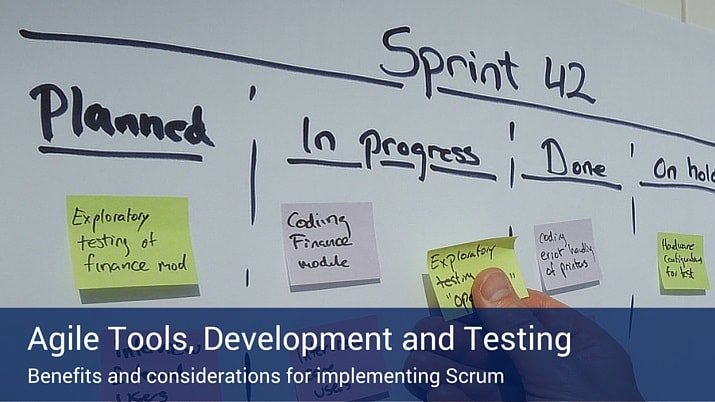Agile Tools, Software Development and Testing

Last Updated October 14, 2015
Agile is as much a frame of mind as it is an actual methodology. That said, there are tools available that may help understand and implement its methodology. When evaluating different software options for adopting Agile in the workplace, the following areas should be considered.
Project Needs – The first consideration is whether the tool meets the specific needs of the project. While Agile tends to favor flexibility and communication over extensive, pre-project documentation, it does benefit from a system where team members can plan, track and outline. An effective Agile tool should facilitate decision-making by the team and product owner by featuring all relevant details of the project.
Unique Team Dynamics – Agile is not meant to be a one-size-fits-all approach. Rather, the emphasis here is on individual project needs and communication between team members. The same is true of Agile tools: A good Agile tool must be customizable to allow for the individual work styles of team members.
Support – An effective Agile tool must also support the flexibility inherent in the approach. This means that it must allow project parameters to be changed from one sprint to the next at an individual-requirements level. Traditional tools tend to be heavily automated, which may not work with the evolving nature of an Agile project.
Accommodation – As teams learn from sprint-to-sprint, Agile demands that they incorporate new changes and processes that can help projects progress more smoothly. An effective Agile tool should accommodate this change in project design and allow for reconfiguration of overall aims and strategy.
Agile in Software Development
The concept of Agile was born in software development, and it is here that it is typically at its most streamlined and effective. Writing software for a client can be a difficult process, generally requiring a very clear sense of what the client wants the software to do and whether those needs might change. Clients usually like to see their software delivered as quickly as possible, particularly if their business depends on it. For these reasons, it is vital to have a management approach that facilitates communication and puts out deliverables as quickly as possible.
In other approaches, developers might write a program in its entirety and delay bug testing and additional features to the point the program is delivered to the client. With Agile, however, developers begin coding the most important features almost immediately in short sprints. Doing so can allow the developers to present a functional version of the software incredibly quickly. This program may not have all of the features the client wants in the finished version, but it will work, allow the client to get used to working with it and have a significant voice in the continued development process.
Agile Testing Challenges
While Agile can present significant benefits in a software environment, its adoption is not without growing pains. The issue here lies in trying to adapt traditional testing methods to the Agile approach, which can be different.
In traditional software testing, tools are used to debug programs when they are completed. The program is built in its entirety and testing happens at the end. Until recently, this traditional approach had been considered highly effective, and it had entrenched itself firmly in the work processes of software developers.
The nature of Agile, however, is that testing happens as the program is being built. Each sprint cycle ends with a period of testing and review, meaning that the program is constantly being analyzed and adjusted. While this certainly has its advantages, it may present a problem in that software developers are unable to use traditional automated testing programs to facilitate testing.
In essence, Agile teams have to learn how to test their program manually as they go. As the program becomes bigger and bigger, teams have to test more and more. To avoid reaching a situation where teams are testing more than building, it is imperative that teams consider how they are going to adjust their testing processes as the project unfolds.







